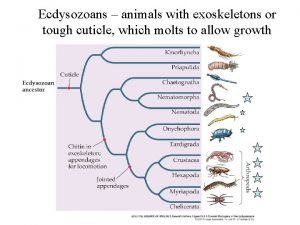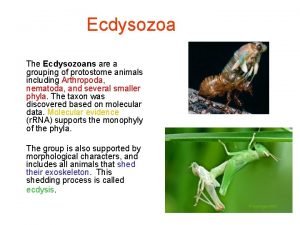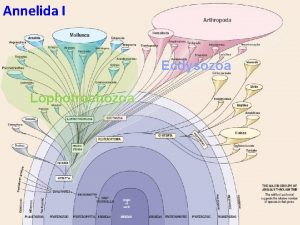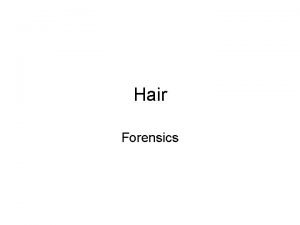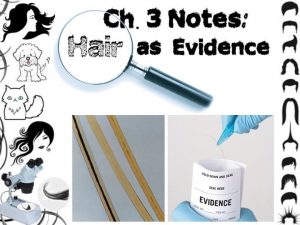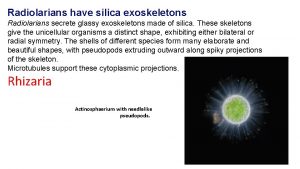Ecdysozoans animals with exoskeletons or tough cuticle which










- Slides: 10

Ecdysozoans – animals with exoskeletons or tough cuticle, which molts to allow growth

Nematoda - roundworms • pseudocoelomate • not an exoskeleton as such, but a thick cuticle that is shed as the animal grows. • Live in waters, soils, and as parasites of both animals and plants. • One of the most diverse groups of organisms on earth. – 25, 000 species described – Perhaps millions still unknown


Ecdysozoans with unjointed legs • Cuticle contains chitin, so these phyla are related to the arthropods. • Onychophora Tardigrada (“water bears”)

Arthropods • Rigid exoskeleton • Jointed legs • “Arthropoda” was formerly regarded as a phylum, but is now seen as a group of 4 related phyla • Crustacea – shrimp, lobsters, crabs • Hexapoda – includes class Insecta (insects) • Myriopoda: centipedes and millipedes • Chelicerata – spiders, mites, lice, scorpions

Crustacea • • 3 regions: Head, thorax, and abdomen Multiple segments in thorax and abdomen 5 pairs of appendages on head One pair of appendages on each thoracic or abdominal segment • Appendages specialized for various uses: antennae, jaws, legs, swimmerettes, etc.


Phylum Hexapoda • • One main class, the insects (Insecta) Head, thorax, and abdomen 6 legs on thorax Some important orders (see pictures P. 649): – – – Odonata: Dragonflies Orthoptera: Crickets, grasshoppers, roaches Coleoptera: Beetles Diptera: Flies Lepidoptera: Butterflies, moths Hymenoptera: Bees, wasps, ants

Phylum Miriapoda • Centipedes and millipedes • Many approximately equal body segments • Legs on every segment – One pair per segment in centipedes – Two pairs per segment in millipedes

Phylum Chelicerata • Spiders, mites, ticks, and scorpions • Often with four pairs of walking legs • The most important class is the Arachnida (spiders)
